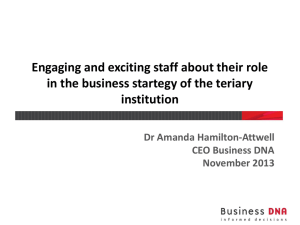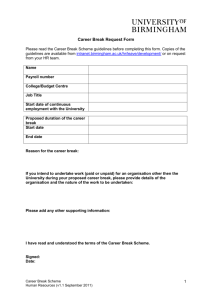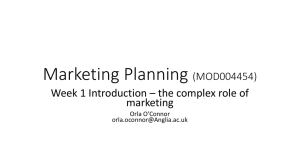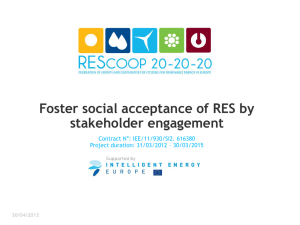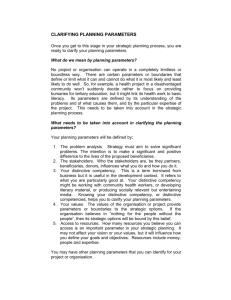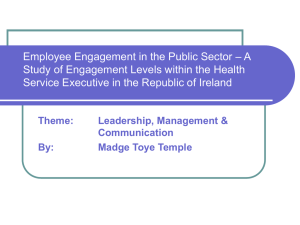Chapter 6
advertisement
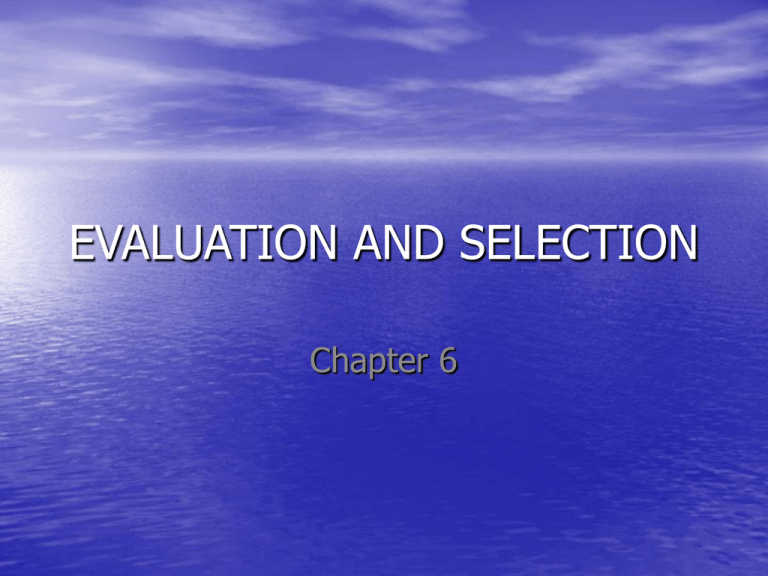
EVALUATION AND SELECTION Chapter 6 Objectives Upon completion of this chapter, you should be able to: • Critically understand the process of strategy evaluation. • Identify criteria to evaluate strategic options • Evaluate your organisations strategy using different criterions. • Perform gap analysis • Explain how strategic decision making is concluded in your organisation. • Optimise your preferred strategic option and plan how to make a case in support of your option. Introduction Strategy can neither be formulated nor adjusted to changing circumstances without a process of strategy evaluation an selection. Whether performed by an individual or as part of an organisation review procedures, strategy evaluation and selection forms an essential step in the process of guiding an enterprise. Strategy Evaluation • It is an attempt to look beyond the obvious facts regarding the short-term health of a business and appraise instead those more fundamental factors and trends that govern success in the chosen field of endeavor. The Challenge of Evaluation • It is accomplished, the products of a business strategy evaluation are answers to these three questions: – Are the objectives of the business appropriate? – Are the major policies and plans appropriate? – Do the results obtained to date confirm or refute critical assumptions on which the strategy rests? • Devising answers to these questions is neither simple nor straightforward. It requires reasonable store of situation-based knowledge and more than the usual degree of insight. • The major issues which make evaluation difficult and with which the analyst must come to grips are: – Each business strategy is unique. Strategy evaluation must rest on the type of situational logic that does not focus on “one best way” but which can be tailored to each problem as it is faced. – Strategy is centrally concerned with the selection of goals and objectives. Many people including seasoned executives find it much easier to set or try to achieve goals than to evaluate them. • Formal systems of strategic review, while appealing in principal can create explosive conflict situations. Not only are there serious questions as to who is qualified to give an objective evaluation, the whole idea of strategy evaluation implies management by “much more than results” and runs counter to much of currently popular management philosophy. Criteria for Evaluation (Refer to page 195) Johnson & Scholes – identified 6 broad criteria against which to evaluate options: 1.Consistency with the purpose of the organisation: a prime test for evaluation and selecting strategies. 2.Suitability of the strategy for the environment within which the organisation operates. 3.Validity of the projections and data used in developing the option must be tested. 4.Feasibility 5.Business risk also needs to be assessed because it may be unacceptable to the organisation. 6.Attractiveness to stakeholders: some options maybe more appealing than others to shareholders, employees, government etc Gap Analysis • It is a business assessment tool enabling a company to compare its actual performance with its potential performance. • Provides the company with insight to areas which have room for improvement • Process involves determining, documenting and approving the variance between business requirements and current capabilities. • Gap analysis naturally flows from • Once the general expectation of performance in the industry is understood then it is possible to compare that expectation with the level of performance at which the company currently functions. • This comparison becomes gap analysis. Such analysis can be performed at the strategic or operational level of an organisation. • At some point a gap will have emerged between what the existing products offer the consumer and what the consumer demands. That gap has to be filled if the organisation is to surivive and grow. Strategic investment decision making • This involves the process of identifying, • • • evaluating and selecting among projects that are likely to have a significant impact on the organisation’s competitive advantage. More specifically the decision will influence what the organisation does, where it does and/or how it does it. Strategic investment decision making process is arguably one of senior management’s greatest challenges. There is a critical need to get these decisions right. It has all the elements of a cost-benefit analysis. Making a case • Effective communication has 6 main characteristics: – Relevance – Reliability – Understandability – Significance – Sufficiency – practicality • The way you make a case for your strategic option will depend on your organisation’s procedures and expectations. • The following checklist can be used as a guide (page 207) : – Define the strategy proposed – Suitability of the proposal – Acceptability – Feasibility – Timings – Gaining support



